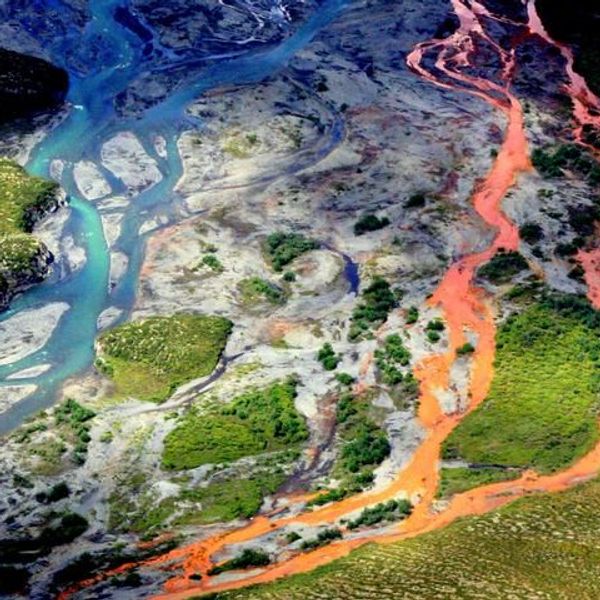If You Thought the Southern Antarctic Peninsula Glaciers Were Stable, Think Again
New research finds region once thought secure is undergoing dramatic ice loss
A group of scientists on Thursday published evidence that the Southern Antarctic Peninsula, a region where glaciers were previously thought to be stable, is now undergoing sudden--and dramatic--ice loss due to the warming of the ocean.
Published in the journal Science under the title Dynamic thinning of glaciers on the Southern Antarctic Peninsula, the research was led by a group of University of Bristol researchers.
A research summary explains, "Using measurements of the elevation of the Antarctic ice sheet made by a suite of satellites, the researchers found that the Southern Antarctic Peninsula showed no signs of change up to 2009."
However, the statement continues, "Around 2009, multiple glaciers along a vast coastal expanse, measuring some 750km in length, suddenly started to shed ice into the ocean at a nearly constant rate of 60 cubic km, or about 55 trillion litres of water, each year.
Lead researcher Dr. Bert Wouters, from the University of Bristol, said the findings "came as a surprise."
"To date, the glaciers added roughly 300 cubic km of water to the ocean," said Wouters. "That's the equivalent of the volume of nearly 350,000 Empire State Buildings combined."
The findings mean that the region "is the second largest contributor to sea level rise in Antarctica and the ice loss shows no sign of waning," say researchers.
This study comes on the heels of a NASA report released last week, which found that the Antarctic shelf is close to disintegration.
An Urgent Message From Our Co-Founder
Dear Common Dreams reader, The U.S. is on a fast track to authoritarianism like nothing I've ever seen. Meanwhile, corporate news outlets are utterly capitulating to Trump, twisting their coverage to avoid drawing his ire while lining up to stuff cash in his pockets. That's why I believe that Common Dreams is doing the best and most consequential reporting that we've ever done. Our small but mighty team is a progressive reporting powerhouse, covering the news every day that the corporate media never will. Our mission has always been simple: To inform. To inspire. And to ignite change for the common good. Now here's the key piece that I want all our readers to understand: None of this would be possible without your financial support. That's not just some fundraising cliche. It's the absolute and literal truth. We don't accept corporate advertising and never will. We don't have a paywall because we don't think people should be blocked from critical news based on their ability to pay. Everything we do is funded by the donations of readers like you. Will you donate now to help power the nonprofit, independent reporting of Common Dreams? Thank you for being a vital member of our community. Together, we can keep independent journalism alive when it’s needed most. - Craig Brown, Co-founder |
A group of scientists on Thursday published evidence that the Southern Antarctic Peninsula, a region where glaciers were previously thought to be stable, is now undergoing sudden--and dramatic--ice loss due to the warming of the ocean.
Published in the journal Science under the title Dynamic thinning of glaciers on the Southern Antarctic Peninsula, the research was led by a group of University of Bristol researchers.
A research summary explains, "Using measurements of the elevation of the Antarctic ice sheet made by a suite of satellites, the researchers found that the Southern Antarctic Peninsula showed no signs of change up to 2009."
However, the statement continues, "Around 2009, multiple glaciers along a vast coastal expanse, measuring some 750km in length, suddenly started to shed ice into the ocean at a nearly constant rate of 60 cubic km, or about 55 trillion litres of water, each year.
Lead researcher Dr. Bert Wouters, from the University of Bristol, said the findings "came as a surprise."
"To date, the glaciers added roughly 300 cubic km of water to the ocean," said Wouters. "That's the equivalent of the volume of nearly 350,000 Empire State Buildings combined."
The findings mean that the region "is the second largest contributor to sea level rise in Antarctica and the ice loss shows no sign of waning," say researchers.
This study comes on the heels of a NASA report released last week, which found that the Antarctic shelf is close to disintegration.
A group of scientists on Thursday published evidence that the Southern Antarctic Peninsula, a region where glaciers were previously thought to be stable, is now undergoing sudden--and dramatic--ice loss due to the warming of the ocean.
Published in the journal Science under the title Dynamic thinning of glaciers on the Southern Antarctic Peninsula, the research was led by a group of University of Bristol researchers.
A research summary explains, "Using measurements of the elevation of the Antarctic ice sheet made by a suite of satellites, the researchers found that the Southern Antarctic Peninsula showed no signs of change up to 2009."
However, the statement continues, "Around 2009, multiple glaciers along a vast coastal expanse, measuring some 750km in length, suddenly started to shed ice into the ocean at a nearly constant rate of 60 cubic km, or about 55 trillion litres of water, each year.
Lead researcher Dr. Bert Wouters, from the University of Bristol, said the findings "came as a surprise."
"To date, the glaciers added roughly 300 cubic km of water to the ocean," said Wouters. "That's the equivalent of the volume of nearly 350,000 Empire State Buildings combined."
The findings mean that the region "is the second largest contributor to sea level rise in Antarctica and the ice loss shows no sign of waning," say researchers.
This study comes on the heels of a NASA report released last week, which found that the Antarctic shelf is close to disintegration.

